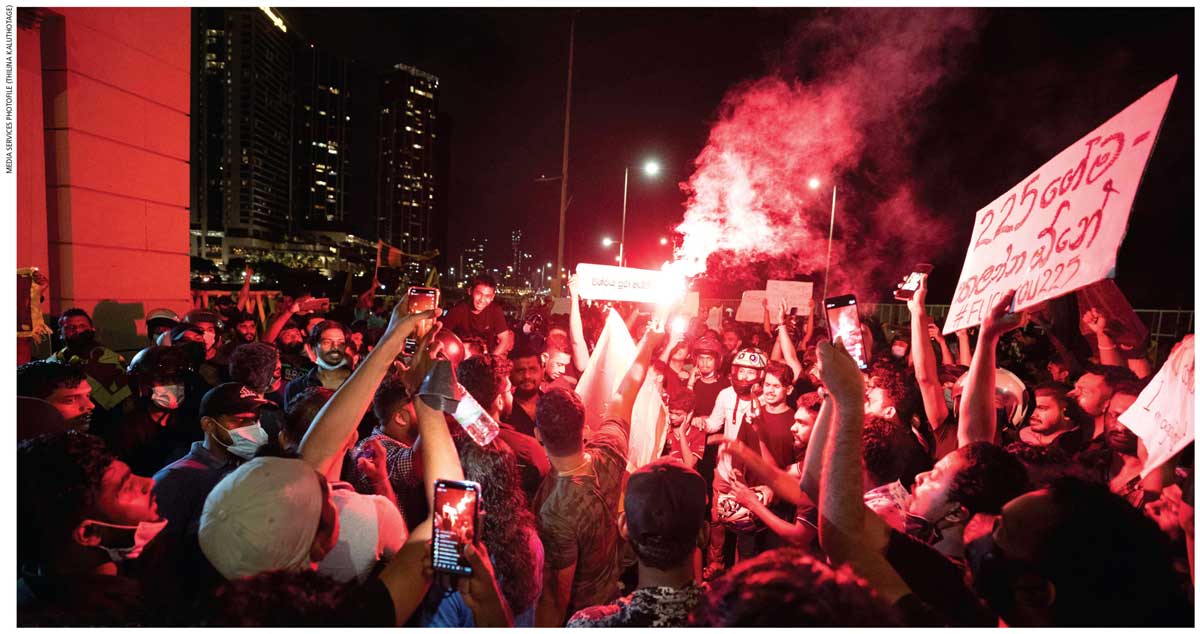STATE OF THE NATION
VIEWPOINTS
MAY THE FORCE (A NEW HOPE) BE WITH US
Wijith DeChickera looks back a month and year so as to look forward with a modicum of confidence in the future of a nation not at peace
The merry month of May surprised Sri Lanka with some measure of serenity. At Vesak – which has time out of mind been a festival to unite islanders of all faiths and philosophies in a feeling of solidarity at least, and sustainable unity at best – there was a new hope in the waterlogged streets under a storm wracked sky.
For one, even the most modest dwelling in the meanest mews – i.e. Colombo’s ‘trishaw-waththas’ – dug deep into customarily empty domestic coffers to deck their neighbourhoods with penta-coloured flags, humble but warmly glowing lanterns and often more sophisticated illuminated creations. This perhaps brought home a sense of illusory belonging to and in a nation that has of late been undergoing a severe and seemingly irreversible brain drain.
And for another, the sheer number of dansal (free eateries where the public from the poorest of the poor to patrons of the reciprocal merit seeking that characterises the Buddha’s way of life) surprised the typically cynical citizens of the country’s commercial capital with their unexpected hospitality.
Coming at a time when an estimated quarter of (and maybe unseen millions more) Sri Lankans are facing food insecurity, malnutrition and even starvation, this was a morale booster indeed.
Taken together with Forbes’ April listing of our Indian Ocean island pearl as ‘one of the best places to travel in 2023,’ this counterintuitive hospitality – a generous grace to others in the face of one’s own adversity – is what could set Sri Lanka apart from other pretty girls (so to say) on the beaches of South Asian tourism for the rest of the decade.
That Sri Lankan smile wins at home and away… ehi passiko – ‘come and see.’ A blurb on a video compiled by two inspiring young Sri Lankan vloggers declares with pride and justification: “We spent the last 43 days cycling around Sri Lanka to show tourists from all parts of the world that not only is Sri Lanka safe but it is also one of the best travel destinations for those looking to go off the beaten path.”
Not only during Vesak – the path trod by the Tathāgatha many moons ago – a feast for the senses and stomach meanwhile, it is also a tool for statesmanship to position Sri Lanka on the moral, cultural and sociopolitical maps of a world at war with itself and its neighbours.
If only a savvy Sri Lankan statesman of the ilk of the late Srilankabhimanya Lakshman Kadirgamar had the erudition, insight and eloquent wit to leverage the commemoration of Gautama Siddharta’s birth, death and enlightenment to our island’s benefit, it would go no little distance in redeeming the gravitas of a nation – once proudly acclaimed as the ‘Granary of the East’ – in the esteem of a world hungry for moral, spiritual and truly religious succour.
Not everything was sabbe satta bhavantu sukhitatta (‘may all beings be happy’) last month however, even as the maudlin month of May regurgitated a vomitus of bitter memories from the politically motivated mayhem of the same time in the last year.
Since the then authorities’ sponsored attacks on peaceful protestors at public rallies that were the order of the day in mid-2022, a prime minister has resigned and a president been ousted.
But despite salutary political ends the erstwhile aragalaya achieved, there is no sustainable rewriting of the social contract – save the cosmetic restoration of law and order under an administration ostensibly more authoritarian that the regime it replaced; consolidation of an IMF programme in the form of an Extended Fund Facility (EFF) to the tune of US$ 3 billion dollars; and discrediting the youth movement that effected regime change.
And although a coalition of the willingly led – spanning the socioeconomic gamut from major business tycoons and minor trishaw businessmen; and a political spectrum encompassing conservatives in the main, liberals to a larger extent and perhaps a few odd progressives – has embraced the status quo, the root causes that provoked a protracted ‘people’s struggle’ (felt at its violent worse in May and July 2022) have not been addressed or mitigated.
For there is more to life for an island people under a benevolent tropical sun than gas to cook made readily available, fuel and at repeatedly slashed prices with a pricing formula to come and the QR code driven quota system reportedly to be abolished soon.
Of course, this abundant life must not come at the cost of painful social upheavals that sometimes only consolidate the status quo; pseudorevolutions that reinstate the oppressor in power in another almost unrecognisable shape; and threaten to hang the Damocles’ sword of revolution by bloodshed and setting the country ablaze over all our heads.
That boat has not quite sailed or been sunk – as evinced by the inordinate persistence of passionate agitation by not only radicalised youth but also respectable segments of civil society from artistes and activists to conscience-smitten clergy.
The aragalaya at its best and worst is far from over, and it is a dull and inane establishment that ignores it in the false hope that food and fuel security alone – bolstered by a draconian antiterrorism act – will stifle it.
Coming at a time when an estimated quarter of (and maybe unseen millions more) Sri Lankans are facing food insecurity, malnutrition and even starvation, this was a morale booster indeed





